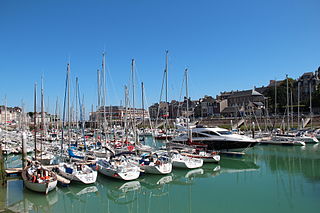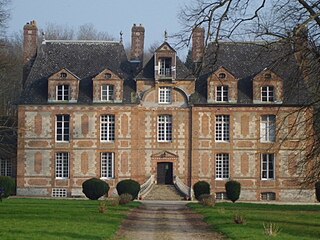
Seine-Maritime is a department of France in the Normandy region of northern France. It is situated on the northern coast of France, at the mouth of the Seine, and includes the cities of Rouen and Le Havre. Until 1955 it was named Seine-Inférieure. It had a population of 1,255,633 in 2019.

The Pays de Caux is an area in Normandy occupying the greater part of the French département of Seine Maritime in Normandy. It is a chalk plateau to the north of the Seine Estuary and extending to the cliffs on the English Channel coast; its coastline is known as the Côte d'Albâtre. In the east, it borders on the Pays de Bray where the strata below the chalk show through.
Caudebec-en-Caux is a former commune in the Seine-Maritime department in the Normandy region in northern France. On 1 January 2016, it was merged into the new commune of Rives-en-Seine.

Rouen Cathedral is a Catholic church in Rouen, Normandy, France. It is the see of the Archbishop of Rouen, Primate of Normandy. It is famous for its three towers, each in a different style. The cathedral, built and rebuilt over a period of more than eight hundred years, has features from Early Gothic to late Flamboyant and Renaissance architecture. It also has a place in art history as the subject of a series of impressionist paintings by Claude Monet.

The Arrondissement of Rouen is an arrondissement of France in the Seine-Maritime department in the Normandy region. It has 216 communes. Its population is 631,032 (2016), and its area is 1,936.1 km2 (747.5 sq mi).

Saint-Valery-en-Caux is a commune in the Seine-Maritime department in the Normandy region in northern France.

Ancretiéville-Saint-Victor is a commune in the Seine-Maritime department in the Normandy region in northern France.

Saint-Paër is a commune in the Seine-Maritime department in the Normandy region in northern France.

Hermeville is a commune in the Seine-Maritime department in the Normandy region in northern France.

Reuville is a commune in the Seine-Maritime department in the Normandy region in northern France.
Boudeville is a commune in the Seine-Maritime department in the Normandy region in northern France.

Sainte-Marie-des-Champs is a commune in the Seine-Maritime department in the Normandy region in northern France.

Villequier is a former commune in the Seine-Maritime department in the Normandy region in northern France. On 1 January 2016, it was merged into the new commune of Rives-en-Seine.

Saint-Pierre-lès-Elbeuf is a commune in the Seine-Maritime department in the Normandy region in northern France.

Esteville is a commune in the Seine-Maritime department in the region of Normandy, France.
La Houssaye-Béranger is a commune in the Seine-Maritime department in the Normandy region in northern France.
Saussay is a commune in the Seine-Maritime department in the Normandy region in northern France.
La Rue-Saint-Pierre is a commune in the Seine-Maritime department in the Normandy region in northern France. It belongs to the Arrondissement of Rouen and the Canton of Le Mesnil-Esnard. The inhabitants are called Bocassiens.
The Canton of Doudeville is a former canton situated in the Seine-Maritime département and in the Haute-Normandie region of northern France. It was disbanded following the French canton reorganisation which came into effect in March 2015. It consisted of 17 communes, which joined the canton of Yvetot in 2015. It had a total of 8,220 inhabitants (2012).
The Canton of Yvetot is a canton situated in the Seine-Maritime département and in the Normandy region of northern France.



















